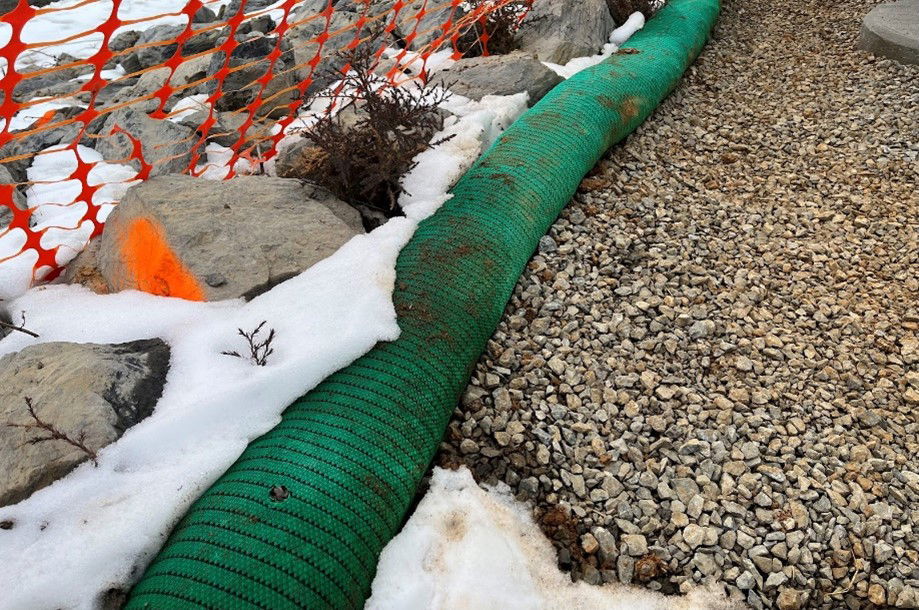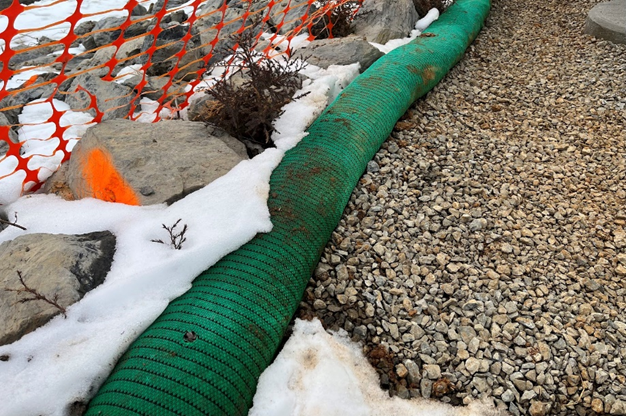Perimeter Control Selection for Erosion Control

By far, the most common perimeter control for Erosion and Sediment Control (ESC) that inspectors at Aegis encounter is silt fence-- whether it’s used on the construction of a thousand-acre solar site, a stockpile of ten cubic yards of soil, or substation fence upgrade. However, a more thoughtful approach to perimeter control selection and application could save a project a significant amount of time and money.
Wattles, Sediment Logs, Silt Socks, and Coir Logs

Above: silt sock is used instead of silt fence for perimeter controls on a fence installation project to eliminate ground disturbance from trenching and to allow for easier temporary removal and repositioning while crews are working on the fence section in a given area.
New alternatives are being developed every day that are lower cost, more sustainable, require less time and labor to install and remove, and/or involve far less ground disturbance. One approach with many variations is the wattle, sediment log, coir log, silt sock, etc. Given the inconsistent naming conventions and the variation in mesh casing material and filler blends, it is important to confirm the specifications and composition are optimized for the needs of your project.
Heavier wattles (like compost wattles) and wattles that absorb a lot of water (like coir logs) are ideal for saturated conditions and steeper slopes on projects like shore restoration, check dams in drainage ditches, slope interruption, and building detention basins. Lightweight wattles that do not retain water and have a durable mesh work well in areas where they will be moved frequently to meet the needs of the project (like soil stockpiles, across construction roads, and as slope diversions during grading). Most socks/wattles are filled with natural, recycled, biodegradable materials that can be left in place at the end of the project. Some manufacturers offer filtering blends tailored to treat stormwater for a variety of pollutants, such as bacteria, heavy metals, nutrients, etc. Unlike silt fence, the heavier versions of socks can be installed on hard and impervious surfaces, which allows the socks to serve functions such as drop inlet protection in a parking lot. Additionally, many manufacturers’ specifications do not require trenching when installed on pervious surfaces—an additional, noteworthy advantage over silt fence. This can reduce installation time by at least 20-30% when compared to silt fence installation by trencher or by hand.6 Each variation of sock/wattle has its own unique pros and cons:
- Coir Logs: filled with coconut fibers
- 100% biodegradable
- Absorb 150-200% water by weight
- Functional lifespan of 2 – 5 years
- Ideal for saturated or water-associated projects like shore restoration
- Good growth medium for new vegetation
- “Recommended for low energy sites such as ponds and streams.”1
- Difficult to move to a new location once saturated, so they are more appropriate in places where repositioning won’t be necessary
- Wattles: most frequently filled with straw (aka “erosion logs”, “straw wattles”)
- Can be less expensive than other sock fill materials
- Lightweight construction and low water retention means they are not ideal for high flows or steep slopes, but are easier to move and relocate
- Wattles filled with straw are less effective at treating and filtering runoff than most other types of fill material
- Compost wattles: commonly filled with wood chips
- Heavier than straw or wood fiber, so they’re ideal for higher flows but not for situations where they will need to be repositioned
- Add nutrients to the soil (assuming compost spread into the surrounding area at the end of the project)
- Hard surfaces (without staking) or on bare soil, perimeter controls, inlet protection, higher-flow areas.
- Sediment Logs: commonly filled with wood fibers
- Lighter weight than compost wattles
- Generally pass higher flow rates than straw wattles, and retain more sediment
- Can be more expensive than alternative sock fill blends
- Continuous mesh socks filled in the field with a blower truck:
- Eliminates the need for wattle overlap because the outer mesh is continuous with virtually no limit on the length
- Empty mesh is far lighter; socks are placed prior to filling, so filled socks do not need to be moved
- Blower truck needed for installation
Often, removal of these socks at the end of a project can be completed with no heavy equipment by cutting open and pulling away the casing, raking the sock fill material into the existing grade, and applying seed. Some of the completely biodegradable socks are pre-filled with seed and grow media, eliminating the need for removal, while jump-starting the stabilization process.
Erosion Eels (ACF Environmental)
Erosion eels are similar to silt socks and wattles in how they function and are installed. However, since they are filled with non-biodegradable, recycled rubber material, they cannot be left in place at the end of a project. Some of the benefits listed on ACF’s website7 include:
- “Easy installation with no trenching required
- Durable, reusable, and easily moved
- DOT Approved in many states
- Replaces silt fence, rock check dams, temporary diversion berms, and storm/inlet drain protection
- Weight of unit holds it securely to curb surface”
Brush Barriers
Brush Barriers could be a viable alternative to silt fence in short term, low-flow applications which already involve clearing and grubbing of a large amount of vegetation prior to grading. By piling the residue material from grubbing into brush barriers along the perimeter on projects with shorter timelines and/or smaller drainage areas, contractors can combine grubbing and perimeter controls installation into a single step. In the experience of one Aegis inspector, when brush piles were used longer term (more than 6 months), he found they were difficult to inspect and clean out by hand. He also noted the brush barriers could not hold up to high-velocity flow. Brush barriers used as perimeter controls on projects with a short timeline (2-4 months) and smaller drainage areas could be optimal since maintenance needs and surface water flows would be reduced.
Additional thoughts on perimeter control selection
Oftentimes Aegis sees silt fence used more as a delineation of project bounds or property line than for erosion and sediment control; specifically, silt fence installed along the perimeter up-gradient of the land disturbance. On the one side is the “it can’t hurt” argument, but on the flip side there is the considerable amount of unnecessary land disturbance that occurs when installing silt fence and again upon removal. ESC plan design that identifies areas where perimeter controls are unnecessary could eliminate a substantial amount of cost, labor, maintenance, and land disturbance in these areas.
1 https://www.eastcoasterosion.com/products/sediment-control-logs/12-standard-coir-log/
2 https://udfcd.org/wp-content/uploads/uploads/vol3%20criteria%20manual/12_SC-02%20Sediment%20Control%20Log.pdf
3 https://www.millbornseeds.com/erosion-control/sediment-logs-wattles/
4https://www.filtrexx.com/en/resources/product-selection-guide
5http://americanexcelsior.com/wp-content/uploads/2015/02/Curlex-Sediment-Logs-PD.pdf
6 Filtrexx SiltSoxx Installation vs Silt Fence and Straw Wattles – YouTube
7https://acfenvironmental.com/products/perimeter-and-sediment-control/perimeter-control-tubes/erosion_eel/